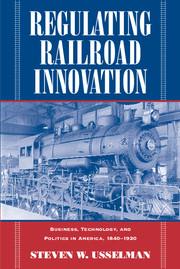Book contents
- Frontmatter
- Contents
- List of Illustrations
- Preface and Acknowledgments
- Introduction
- Part I ASSEMBLING THE MACHINE, 1840–1876
- Part II RUNNING THE MACHINE, 1876–1904
- 4 Patent Remedies: Politics, Jurisprudence, and Procedure
- 5 Mastering Technology, Channeling Change
- 6 Standardizing Steel Rails: Engineered Innovation
- 7 Engineering Enshrined
- Part III FRICTION IN THE MACHINE, 1904–1920
- Epilogue: The Enduring Challenge of Innovation
- Index
4 - Patent Remedies: Politics, Jurisprudence, and Procedure
from Part II - RUNNING THE MACHINE, 1876–1904
Published online by Cambridge University Press: 12 August 2009
- Frontmatter
- Contents
- List of Illustrations
- Preface and Acknowledgments
- Introduction
- Part I ASSEMBLING THE MACHINE, 1840–1876
- Part II RUNNING THE MACHINE, 1876–1904
- 4 Patent Remedies: Politics, Jurisprudence, and Procedure
- 5 Mastering Technology, Channeling Change
- 6 Standardizing Steel Rails: Engineered Innovation
- 7 Engineering Enshrined
- Part III FRICTION IN THE MACHINE, 1904–1920
- Epilogue: The Enduring Challenge of Innovation
- Index
Summary
Though the impetus for reshaping the paths of innovation in American railroading originated from forces that transcended the immediate problems with patents, railroad managers could not succeed in imposing new discipline over technology without resolving the nagging uncertainties regarding the patent system. By the mid-1870s, the ongoing struggles with the likes of Westinghouse and Sayles had pushed executives such as Robert Harris well beyond the point of exasperation. Managers recognized that the disputes involving these patents posed a fundamental threat to their industry. For at root, the attempts to regulate safety and to allocate damages in patent cases pointed to a common issue of basic importance for the emerging corporate age: Should credit for improvements in productivity and performance go primarily to inventors or to the corporate managers who ran the complex machine? Who offered the surer path to safety? Who responded more effectively to public demand? These questions, in turn, touched upon the very nature of markets and the role of government in structuring incentives. The persistent tension inherent in the patent system, which purported to serve the public interest by granting monopoly privileges to individuals, came under renewed scrutiny. Indeed, that tension seemed in many respects to encapsulate the fundamental concerns of an age in which legislatures and courts wrestled continually with questions about the authority of state and federal governments to create and regulate monopolies.
- Type
- Chapter
- Information
- Regulating Railroad InnovationBusiness, Technology, and Politics in America, 1840–1920, pp. 143 - 176Publisher: Cambridge University PressPrint publication year: 2002



